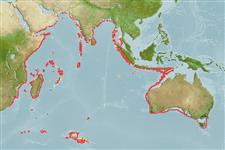Environment: milieu / climate zone / depth range / distribution range
Écologie
marin bathydémersal; profondeur 265 - 458 m (Ref. 58018). Deep-water
Western Indian Ocean: southern Indonesia (off the south coast of Java) and SW Thailand to India (off Chennai, Tuticorin and Kerala), the Gulf of Aden and off the coast of Somalia. Records from the Philippines, the South China Sea and elsewhere in the western Pacific Ocean are misidentifications.
Taille / Poids / Âge
Maturity: Lm ? range ? - ? cm
Max length : 17.0 cm SL mâle / non sexé; (Ref. 95053); common length : 12.0 cm TL mâle / non sexé; (Ref. 9133)
Épines dorsales (Total): 10 - 11; Rayons mous anaux: 9 - 10. This species is distinguished by the following set of characteristics: lower jaw terminating in a distinct forwardly projecting horizontal plate with strong, spine-like processes directed forward from the plate’s corners; silvery grey body with numerous minute black spots and traces of broad darker crossbars; black colour at base of anterior dorsal fin spines and distal parts of dorsal fins; adipose fin tiny with numerous black spots; caudal fin black; 3.5 scales above lateral line; 3 rows of cheek scales; very large head, 34.3-40·1% SL; large eye, 29·8-40·8% HL; long pectoral fin, extending to beyond dorsal fin base, 21.7-26.2% SL; body silvery grey with minute black dots and traces of broad darker crossbars; operculum dark dorsally, silvery ventrally (Ref. 95053).
Found offshore (Ref. 30573).
Life cycle and mating behavior
Maturité | Reproduction | Frai | Œufs | Fécondité | Larves
Bineesh, K.K., K.V. Akhilesh, M.F. Gomon, E.M. Abdussamad, N.G.K. Pillai and A. Gopalakrishnan, 2014. Redescription of Chlorophthalmus corniger, a senior synonym of Chlorophthalmus bicornis (Family: Chlorophthalmidae). J. Fish Biol. 84(2):513-522. (Ref. 95053)
Statut dans la liste rouge de l'IUCN (Ref. 130435)
Menace pour l'homme
Harmless
Utilisations par l'homme
Pêcheries: pêcheries vivrières
Plus d'informations
Noms communsSynonymesMétabolismePrédateursÉcotoxicologieReproductionMaturitéFraiRassemblement de ponteFéconditéŒufsDéveloppement de l'œuf
RéférencesAquacultureProfil d'aquacultureSouchesGénétiqueElectrophoresesHéritabilitéPathologiesTraitementNutrientsMass conversion
CollaborateursImagesStamps, Coins Misc.SonsCiguateraVitesseType de nageSurface branchialeOtolithesCerveauxVision
Outils
Articles particuliers
Télécharger en XML
Sources Internet
Estimates based on models
Preferred temperature (Ref.
123201): 10.4 - 15.9, mean 11.8 °C (based on 61 cells).
Phylogenetic diversity index (Ref.
82804): PD
50 = 0.5000 [Uniqueness, from 0.5 = low to 2.0 = high].
Bayesian length-weight: a=0.00195 (0.00095 - 0.00400), b=3.02 (2.83 - 3.21), in cm total length, based on LWR estimates for this species & (Sub)family-body (Ref.
93245).
Niveau trophique (Ref.
69278): 3.6 ±0.5 se; based on size and trophs of closest relatives
Résilience (Ref.
120179): Milieu, temps minimum de doublement de population : 1,4 à 4,4 années (Preliminary K or Fecundity.).
Fishing Vulnerability (Ref.
59153): Low vulnerability (11 of 100).
